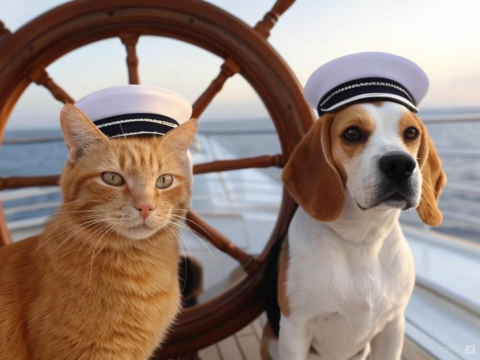How much would you pay to take your cat or dog with you on a cruise?
For some people, the answer would be “a lot”! But the market hasn’t addressed this demand. With the exception of service dogs (who are not pets, and no, buying a harness on eBay doesn’t make her a service dog), pets are not allowed on any regular cruise ship. If you want to bring your four-footed companion, you need to spend $2 million for a condominium cabin on Storylines (which actually has a veterinarian on board). Minor exception: the Queen Elizabeth 2 and Queen Mary 2 will let you place your pet in a kennel, but they can’t stay in your cabin.
Post-COVID, cruising is booming. Disney just ordered eight brand-new cruise liners.
https://www.travelagewest.com/Travel/Cruise/disney-cruise-line-4-new-ships
Other cruise lines are doing the same. Thousands of cruisers would cheerfully pay a substantial extra fee to bring their pets along. I propose the new ships dedicate a certain number of staterooms to being pet-friendly. Modern technology and some common-sense rules can keep everyone safe and comfortable.
The rules
Small pets only. A simple filter would be that they have to be in a carrier that fits underneath a standard airline seat. (So, no German shepherds! Sorry!) And there would be a limit of two or three per stateroom.
Transported only in carriers. Absolutely no provisions for pets to be in common areas, even on a leash. You bring them to your stateroom in the carrier, and you take them off the ship in their carrier. If you want your dog with you at a port of call, they have to cross the gangway in their carrier.
They have to wear a collar with an electronic tag. These RF devices (similar to an Apple AirTag) are becoming more common on cruise ships, with Princess Medallions allowing you to locate members of your party anywhere on the ship within a few feet. Placing one of these on each pet, plus high-resolution location sensors in the designated staterooms, would allow the system to know not just when the pet is in the room, but in what part of the room. This is important (see below).
Supplies. You bring your own litterbox, litter, and food. For dogs, the balcony areas of the designated staterooms will be carpeted with artificial turf, and there will be plastic poop bags, a sealed waste container and a water hose for rinsing the area. If your dog needs lots of running and activity, they’re not going to be a good match for the cruise ship.
Paperwork. You’d need some sort of certificate from your vet, stating that the pet is in good health. You’d need to bring any needed medications. And if the pet gets sick, you’re on your own… you need to get them off the ship, and good luck finding a local vet.
Technology
Each pet-friendly stateroom would have a prominent red or green light displayed on both sides of the door. This display would be keyed to the collar tag(s) of the pet(s) registered to that stateroom. In addition, each pet-friendly stateroom would have one additional door (shown here in green) separating the entry vestibule (shown here in yellow) from the main part of the cabin (green). These diagrams are taken from the Disney Wish, but most ships have similar layouts. Larger suites would make this even simpler.
If the vestibule door is open, the entry light is red. Neither guests nor cabin staff should open the door to the corridor. If you’re headed out of your stateroom and the light is red, don’t leave until you’ve secured your pets. If you’re in the room with the pets running loose, the cabin staff won’t enter to freshen your towels or turn down your bed.
If the vestibule door is closed but one or more tags are detected in the vestibule/bathroom/closet areas, the entry light is red. Same rules apply.
If and only if (1) the vestibule door is closed and (2) all tags are located on the other side, then the light will turn green. Then you may exit the cabin safely without the risk of your pet darting out the door, and cabin staff can enter as well.
Implementation
Staff will need to be firmly instructed to close the corridor door before opening the vestibule door to service the cabin. Similarly, they will have to chase all pets into the bedroom area and secure them behind the vestibule door before attempting to leave. This will slow down servicing each pet-friendly cabin, which is one justification for the increased price.
How much extra? I don’t know. The cruise lines will have to figure that out. It’s a premium service, requiring some investments in technology and in staff training. I’d suggest something like: first pet, $100/day for the first three days, then $30/day thereafter. Second and third pets, $10/day each.
The Disney Wish has 1254 staterooms. If future sister ships configured 10% as pet-friendly (mostly higher-end staterooms and suites, since you’d need the balcony), you could have 120 slots available on each cruise. That would translate to an average of $500/week per stateroom. If they had a “take rate” of 50%, that means an additional $30,000/week of revenue, or $1.5 million/year. It sounds like easy money for the cruise line.
I hope someone tries this!



